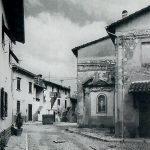The small settlement of Impiano (or Piano), located on a modest plateau (hence the toponym), to the left of the Arno River, is situated along the ancient Roman road that connected the old Via Cassia with the new one. In its vicinity, ceramic materials dating back to the 5th century BC have been found, along with prehistoric stone fragments, which testify to the long and continuous occupation of these areas since pre-Roman times.
The ancient church, dedicated to Saints James and Christopher, was dismantled during World War I. After all the furnishings were removed, the sacred building was converted into a goldsmith’s workshop and private residences (currently number 46 on Via Impiano).
In a small square along the road that crosses the village, a 17th-century altar, transformed into a tabernacle, was placed in the 1950s. It originally came from a church in Peretola, near Florence. Two fluted and grooved Corinthian half-columns support the entablature and the highlighted, broken, and arched pediment, at the center of which is the head of a cherub. A second cherub’s head is found in the entablature, flanked by two elegant garlands of leaves, flowers, and fruit. Inside the tabernacle, in a rounded niche, there is a modestly crafted statue of the Madonna of Fatima.




